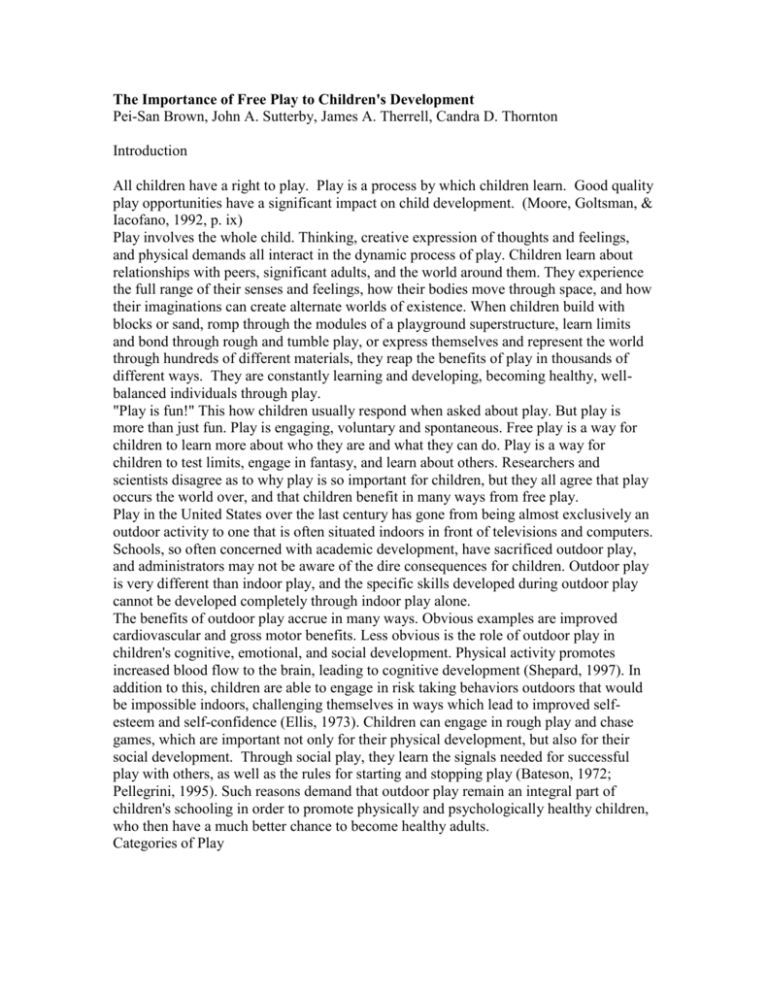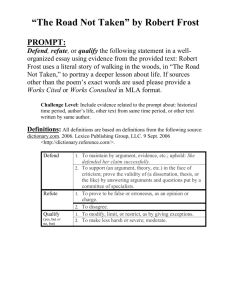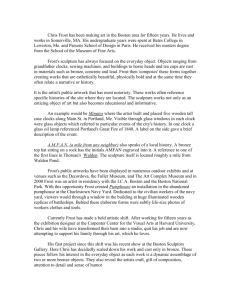The Vital Role of Play in Childhood
advertisement

The Importance of Free Play to Children's Development Pei-San Brown, John A. Sutterby, James A. Therrell, Candra D. Thornton Introduction All children have a right to play. Play is a process by which children learn. Good quality play opportunities have a significant impact on child development. (Moore, Goltsman, & Iacofano, 1992, p. ix) Play involves the whole child. Thinking, creative expression of thoughts and feelings, and physical demands all interact in the dynamic process of play. Children learn about relationships with peers, significant adults, and the world around them. They experience the full range of their senses and feelings, how their bodies move through space, and how their imaginations can create alternate worlds of existence. When children build with blocks or sand, romp through the modules of a playground superstructure, learn limits and bond through rough and tumble play, or express themselves and represent the world through hundreds of different materials, they reap the benefits of play in thousands of different ways. They are constantly learning and developing, becoming healthy, wellbalanced individuals through play. "Play is fun!" This how children usually respond when asked about play. But play is more than just fun. Play is engaging, voluntary and spontaneous. Free play is a way for children to learn more about who they are and what they can do. Play is a way for children to test limits, engage in fantasy, and learn about others. Researchers and scientists disagree as to why play is so important for children, but they all agree that play occurs the world over, and that children benefit in many ways from free play. Play in the United States over the last century has gone from being almost exclusively an outdoor activity to one that is often situated indoors in front of televisions and computers. Schools, so often concerned with academic development, have sacrificed outdoor play, and administrators may not be aware of the dire consequences for children. Outdoor play is very different than indoor play, and the specific skills developed during outdoor play cannot be developed completely through indoor play alone. The benefits of outdoor play accrue in many ways. Obvious examples are improved cardiovascular and gross motor benefits. Less obvious is the role of outdoor play in children's cognitive, emotional, and social development. Physical activity promotes increased blood flow to the brain, leading to cognitive development (Shepard, 1997). In addition to this, children are able to engage in risk taking behaviors outdoors that would be impossible indoors, challenging themselves in ways which lead to improved selfesteem and self-confidence (Ellis, 1973). Children can engage in rough play and chase games, which are important not only for their physical development, but also for their social development. Through social play, they learn the signals needed for successful play with others, as well as the rules for starting and stopping play (Bateson, 1972; Pellegrini, 1995). Such reasons demand that outdoor play remain an integral part of children's schooling in order to promote physically and psychologically healthy children, who then have a much better chance to become healthy adults. Categories of Play Children understand perfectly what free play is and what it isn't--it is adults who need help comprehending the phenomenon. In order to provide a means of organizing all the ways in which free play is engaged, categories of play have been established. The first category is "cognitive play," or types of play which primarily build thinking and reasoning skills. This includes repetitive muscle movements to explore the environment (e.g., repeatedly hitting the ground with a shovel, or repetitively going up and down the steps), exploratory play, pretend play, construction play (e.g., building sand castles), and games with rules. The second category is "social play." This category encapsulates the various ways children interact with peers during free play opportunities. These include solitary/independent play, parallel play (children play beside each other but not with each other), buddy play (2 children play together), and group play. The third category deals with children's physical development. This includes physical growth of the body and vital organs, health-related fitness, and gross and fine motor activities. A fourth category deals with children's emotional development, which includes affective reactions during play. This category includes behaviors such as aggression (intent to hurt) and verbal signals (laughing, crying, etc.). These four categories, cognitive, social, physical, and emotional, cover the spectrum of behaviors children engage in during free play, and they give adults words to use to convey the significance and essential functions of children's play. Cognitive Development during Free Play Despite the manner in which Western culture tends to minimize ("just playing"), dislike ("get serious!"), and trivialize ("burning excess energy") the value of free play, research overwhelmingly provides evidence of the benefits it offers children. Engaging in free play behaviors provides children with a means to explore, interact with, and learn about their environments. "Play contains all developmental tendencies...and is itself a major source of development" (Vygotsky, 1978, p. 102). Friedrich Froebel, inventor of the kindergarten, observed that "Play...is highly serious and of deep significance" (Froebel, 1887, p. 55). Much of children's cognitive development is triggered when they play. Jean Piaget, one of the most highly regarded early childhood theorists, believed that play performs a major role in children's expanding mental abilities (1962). It is through free play that children develop language and manipulative skills, and enhance their means of discovery and creativity (Bodrova & Leong, 1996; Fromberg & Gullo, 1992; Isaacs, 1933; Smilansky & Shefatya, 1990). According to Frost (1992), play is the primary means of development of imagination, intelligence, language, and perceptual-motor abilities in infants and young children. Intellectual processes such as problem solving, reasoning, conceptual abilities and judgment are also being rapidly built during free play (Frost, 1992, 1997; Sylva, 1977, Vygotsky, 1978). Vygotsky (1978) proposed that children have a "zone of proximal development" (ZPD), or a range of tasks between those that children can handle independently and those that they can master with the help of adults or more capable peers. Vygotsky also proposed that: "Play also creates the zone of proximal development of the child. In play a child always behaves beyond his average age, above his daily behavior; in play it is as though he were a head taller than himself" (p. 102). While children are playing, they are building complex abilities of investigation, questioning, exploring, reasoning, testing, hypothesizing, rationalizing, creating, and imagining. Maria Montessori brilliantly captures the role of play in children's cognitive development: "His intelligence no longer develops by existing: it needs a world of things which provide him with motives for his activity. It has been called 'the blessed age of play'" (1967, p. 168). Engagement in free play also affects a second part of children's cognitive development-their brains. Not only does play influence thinking and reasoning, but it also influences young human brain development. Recent neurological research strongly supports the link between play and cognitive development (Frost, 1998) and that children who have had no experience in play suffer cognitive underdevelopment (Bodrova & Leong, 1996). SuttonSmith (1998), when commenting on the drop in the number of synaptic connections from the age 10 months to age 10 years, from 1,000 trillion to 500 trillion stated, "As the brain begins in a state of high potentiality, so does play....Play's function at early stages might...be to assist the actualization of brain potentiality...to save in both brain and behavior more of the variability that is potentially there than would otherwise be saved if there was no play" (p. 333). Due to advances in technology, specifically positronemission tomography (PET) scans, there is scientific evidence that play experiences exert a dramatic and precise impact on development, physically determining how the intricate neural circuits of the brain are wired (Begley, 1997). Social Development during Free Play Play is older than culture…Civilization arises and unfolds in and as play. (Johann Huizinga, 1938) The ideas of Huizinga are profound indeed. He believes that play is the root of our cultural and social development. Play is a foundation of human history as well as a system of transformation. As we play, we imitate and reflect the games and activities of the historical world around us, and we are transformed. He also believes that through play we transform our culture into something new. As children take games and change them to fit new sets of playmates and new play materials, the transformed activities become a part of a new generation’s culture. The games and activities that changed us as children are different than the games and activities that are transforming our own children's culture. The Daniel Boone play of the 1950's has given way to the Barbie play of the 1960's, the He-Man and the Masters of the Universe play of the 1980's, and the Ninja Turtles and PokÈmon play of our current generation. There is no doubt that the play of today is similar in some ways to the play that occurred 50 years ago. However it is often different and often strange to the adults watching culture transform before their eyes, as Charmander and Pikachu replace more familiar names and faces. At the same time, today's child, collapsing at the end of "Ring around the Rosy" has no sense that the game's roots reach all the way back to the Black Plague during the middle ages. The games we play create a common cultural link that ties children to previous generations. It also creates a cultural link between the children themselves. The idea of "peer culture" (Corsaro, 1985), that the culture of children is different than adult culture, rings true. As Peter and Iona Opie (1959) have shown, children have a language all their own and a method of transmission that reaches only the ears of children. Free play is very much a social event because children tend to play together in groups. Even when they play alone, they often play the roles of people they see around them (i.e. parents, siblings, caregivers). Normally, infants’ first play partners are parents who teach them simple games like “peek-a-boo!” Gradually, siblings and peers begin to take more active roles. Without social play, children run the risk of not learning these important skills during childhood. This omission may lead to difficulties in relating to others throughout adulthood (Kemple, 1992). Social play is essential because children cannot simply do as they please but must take into consideration the feelings and ideas of others. Vygotsky (1978) suggests that play has rules that children must follow to continue the play. These rules take into account the characteristics of the role that the child plays as well as those of the children around him. In essence, a child is a constant method actor, taking on the role of the Teacher, the Parent, the Superhero, and immersing himself into the character until he becomes that someone else. Although Piaget (1962) saw children as egocentric, the empathy that children show one another through play signals of their awareness of others. Through play, children learn to take turns, cooperate and share. They also learn the signals that others give that indicate that play is going on, and most importantly, they learn to create a space for play called the play frame, a tool children use to leap together from reality into fantasy (Bateson, 1972). Positive experiences during play are important in later school success (Smilansky and Shefatya, 1990). Physical Development during Free Play Children gain numerous physical benefits from outdoor free play (Frost, Wortham, & Reifel, 2001). As they walk, run, skip, gallop, jump, hop, climb, and hang, they unconsciously strengthen the large muscle groups in their bodies and learn about locomotion, or how to move through space (Gallahue, 1993). As they throw, catch, roll, and kick balls, swing from rung to rung on overhead ladders, climb up or down ladders and stairs, stand up as they reach the bottom of a slide, and walk along landscape timbers or balance beams, they improve hand-to-eye and foot-to-eye coordination. As they walk on sand or pea gravel or mulch, slide down straight and twisting slides, swing on seats or barrels, and try the balance beam, they refine various balancing skills and gain an increase in control over their muscles by resisting gravity (Gallahue, 1993). As they dig in and build with sand, play with toy trucks, animals, and other outdoor objects, pour water between containers, and gently handle caterpillars or other insects, they cultivate their fine motor skills, also known as object manipulation skills (Gallahue, 1993). All of these free play activities and a multitude of others greatly enhance children's physical and perceptual-motor development: Perceptual-motor development results from the interaction between sensory perception and motor actions in increasingly complex and skillful behaviors…. More specifically, visual, auditory, and tactile sensory abilities are combined with emerging motor skills to develop perceptual-motor abilities. (Frost, Wortham, and Reifel, 2001, p. 164) According to Frost et al., perceptual-motor skills include: Body awareness--understanding about the different parts of the body, how they move, what they can do, and how to make movements more efficient. Spatial awareness--understanding about how the body and objects occupy space and how to move them within that space. Directional awareness--understanding about the location and direction of the body and objects in space. Temporal awareness--understanding about the relationship between movement and time (i.e. rhythm, sequencing). Perceptual-motor development helps children become aware of their own bodies and the relationship of their bodies to others and the world around them. Children's physical development also includes health-related benefits, such as aerobic and muscular endurance, strength, flexibility, improvement in the function of vital organs (Ignico, 1994). Outdoor free play provides essential stimulation for children's bodies by increasing blood flow and therefore oxygen to all vital organs, improving aerobic and muscular functioning. Experience in all types of movement, including both gross and fine motor activities, increases muscular responses by strengthening synaptic connections (Gabbard, 1998). Repetition of a variety of movements builds muscle strength and flexibility. Through free play outdoors, children repeat, adapt, and refine all types of movement in various combinations, thereby cultivating their physical skills, development, and health. Emotional Development during Free Play Healthy play and healthy emotional development go hand-in-hand. For children, free play is a time for unbounded expression of their feelings, and in many ways children are their feelings. The more access children have to free play, the greater opportunity they have for expressing themselves during role play, construction play, rough 'n' tumble, and other forms of play. Children often use superstructures and other play elements to engage actively in chase or other role play where expression of feelings are supported in a safe environment (Frost, Kim, Therrell, Thornton, 2000). Also, the more enclosed elements of superstructures are used by children to rest, regain emotional composure, socialize, and make plans for their next role play (Frost, Brown, Sutterby, Therrell, 2000). During pretend play children experiment with different roles that afford opportunities to explore a wide range of emotions (Smilansky, 1990). In a safe and supportive environment, these emotions are "played out." Over time, children are able to make unfamiliar emotions more familiar and less scary (Singer & Singer, 1977), and they are able to exercise greater control over their life than during other, more adult-structured times (Landreth & Hoymeyer, 1998). For example, when children play doctor, parent, baby, or other roles, they develop a wider sense of perspective, increase their understanding or appreciation of other roles, and adapt to difficult, challenging situations. Such adaptations are often therapeutic for children (Landreth, 1991), helping them to heal their immediate emotional wounds and to deal with the powerful, omnipresent pictures of virtual media and real violence in our society (Webb, 1991). Expressing feelings through play permits children to make their own path toward healthy emotional development, along with the support of parents and other significant adults. Conclusion Each one of these four categories, cognitive, social, physical, and emotional, plays an important part in the development of the whole child. We need to insure that children’s free play activities include opportunities for all these elements that are essential to their growth and success. Providing ample, healthy play opportunities fosters the unique potential of each child to learn and develop skills, concepts, and character in a way that only play can provide. References Bateson, G. (1972). Steps to an ecology of mind. New York: Ballantine. Begley, S. (1997, Spring/Summer). How to build a baby's brain. Newsweek Special Edition, 28-31. Bodrova, E. & Leong, D. J. (1996). Tools of the mind: The vygotskian approach to early childhood education. New Jersey: Prentice-Hill. Corsaro, W. (1985). Friendship and peer culture in the early years. Norwood, NJ: Ablex. Ellis, M. (1973). Why people play. Englewood Cliffs, NJ: Prentice Hall Publishing Co. Froebel, F. W. (1887). The education of man. New York: D. Appleton. Fromberg, D. P. & Gullo, D. F. (1992). Perspectives on children. In L. R. Williams & D. P. Fromberg (Eds.), Encyclopedia of early childhood education, (pp. 191-194). New York: Garland Publishing, Inc. Frost, J. L. (1992). Play and playscapes. New York: Delmar Publishers. Frost, J. L. (1997). Child development and playgrounds. Park & Recreation, 32 (4), 5460. Frost, J. L. (1998). Neuroscience, play, and child development. Paper presented at the meeting of the IPA/USA Triennial National Conference, Longmont, CO. Frost, J., Brown, P., Sutterby, J., & Therrell, J.(2000). Outdoor play equipment for infants and toddlers. Austin, TX: Unpublished manuscript. Frost, J., Kim, S., Therrell, J., & Thornton, C. (2000). Play value and safety of play equipment for crawlers, toddlers, and walkers. Austin, TX: Unpublished manuscript. Frost, J., Wortham, S. & Reifel, S. (2001). Play in child development. Columbus, OH: Prentice Hall-Merrill. Gabbard, C. (1998). Windows of opportunity for early brain and motor development. Journal of Physical Education, Recreation, and Dance, 69(8), 54-61. Gallahue, D. L. (1993). Motor development and movement skill acquisition in early childhood education. In B. Spodek (Ed.), Handbook of Research on the Education of Young Children (pp. 24-76). New York: MacMillan Publishing Company. Huizinga, J. (1938). Homo ludens: A study of the play element in culture. Boston: Beacon. Ignico, A. (1994). Early childhood physical education: Providing the foundation. Journal of Physical Education, Recreation, and Dance, 65, 28-30. Isaacs, S. (1933). Social development in young children. London: Routledge & Kegan Paul. Kemple, K. (1992). Preschool childrenís peer acceptance and social interaction. Young Children, 6, 47-54. Landreth, G., (1991). Play therapy: The art of the relationship. Bristol, PA: Accelerated Development. Landreth, G. & Homeyer, L. (1998). Play as the language of children's feelings. In D.P. Fromberg & D. Bergen (Eds.), Play from Birth to Twelve and Beyond: Contexts, perspectives, and Meanings (pp. 193-198). New York: Garland Publishing, Inc. Montessori, M. (1967). The absorbent mind. New York: Henry Holt & Co. Moore, R. C., Goltsman, S. M., & Iacofano, D. S. (Eds.). (1992). PLAY FOR ALL guidelines: Planning, design and management of outdoor play settings for all children (2nd edition). Berkeley, CA: MIG Communications. Opie, I., & Opie, P., (1959). Lore and language of schoolchildren. Oxford: Clarendon Press. Piaget, J. (1962). Play, dreams and imitation in childhood. New York: Norton. Pellegrini, A. (1995). School recess and playground behavior. Albany: State University of New York Press. Shepard, R. (1997). Curricular physical activity and academic performance. Pediatric Exercise Science, 9, 113-126. Singer, D., & Singer, J. (1977). Partners in play: A step-by-step guide to imaginative play in children. New York: Teachers College Press. Smilansky, S. (1990). Sociodramatic play: Its relevance to behavior and achievement in school. In E. Klugman & S. Smilansky (Eds.), Children's play and learning: Perspectives and policy (pp.18-42). New York: Teachers College Press. Smilansky, S. & Shefatya, L. (1990). Facilitating play: A medium for promoting cognitive, socio-emotional, and academic development in young children. Gaithersburg, MD: Psychological and Educational Publications. Sutton-Smith, B. (1998). The ambiguity of play. Cambridge, MA: Harvard University Press. Sylva, K. (1977). Play and learning. In B. Tizard & D. Harvey (Eds.), Biology of play (pp. 59-73). Vygotsky, L. S. (1978). Mind in Society: The Development of Higher Mental Processes. Cambridge, MA: Harvard University Press. Webb, N. (1991). Play therapy with children in crisis. New York: Guilford.








